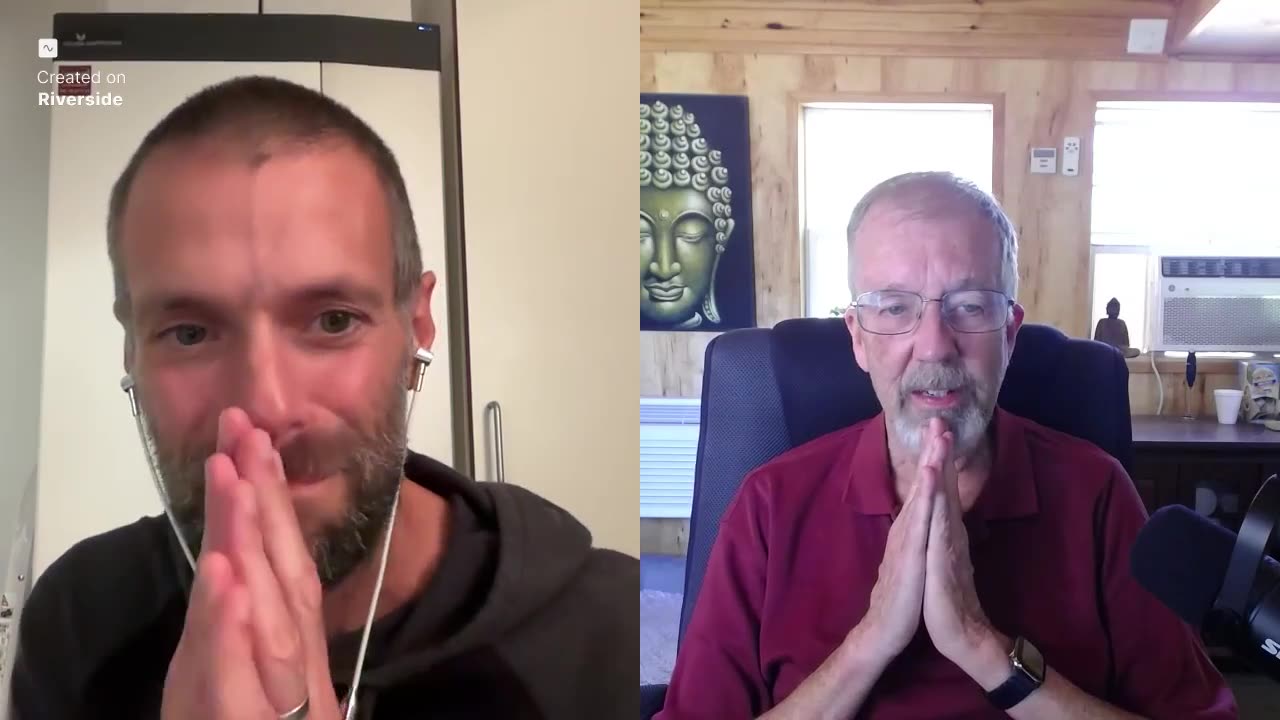Premium Only Content

Aware vs Concentration Jhanas, Buddhist Reconciliation And The Six R's With David Johnson
[Partial AI assisted show notes:] On Oct 22, 2024 I spoke (again this time online) with David Johnson, a meditation practitioner with over 13 years at Dhammasukha. David reflects on his interactions with renowned meditation teachers such as Mahasi Sayadaw and Deepa Ma, as well as his evolving meditation journey. After practicing what's considered by some as Vipassana for many years, David found the results insufficient, prompting him to explore new methods under the guidance of Bhante Vimalaramsi, a monk who developed a meditation style called Tranquil Wisdom Insight Meditation (TWIM).
Key Points:
Shift from Vipassana: David discusses how his exploration of TWIM came after realizing that pure Vipassana wasn’t fully aligning with his expectations. He describes Bhante Vimalaramsi’s method, which blends concentration and insight (Samatha and Vipassana) based on Sutta 149 from the Pali Canon.
TWIM Practice:
TWIM focuses on combining Metta (loving-kindness) and mindfulness meditation to lead to jhanas (meditative absorptions) while applying the six Rs:
Recognize the wandering mind,
Release the distraction,
Relax the tension,
Re-smile,
Return to the object (Metta),
Repeat.
He emphasizes using Metta as a pleasant feeling to cultivate mindfulness, allowing it to naturally deepen into jhanas.
Relaxation and Insight: The key in TWIM is not to force concentration but to gently relax distractions, allowing insight to arise. The method emphasizes acceptance, rather than suppression, of hindrances (such as restlessness or doubt).
Jhanas and Mindfulness: David touches upon the difference between concentration-based jhanas and what he calls “aware jhanas,” which allow practitioners to maintain mindfulness while progressing through meditative states.
Instructions:
Start with Metta: Focus on bringing up feelings of loving-kindness toward yourself, then extend it to a spiritual friend for 20 minutes.
Six Rs: As the mind wanders, apply the six Rs to gently return to the object of meditation without force.
Progress through Brahma Viharas: Once mindfulness is strong, cycle through the four Brahma Viharas (Loving-kindness, Compassion, Sympathetic Joy, and Equanimity) to deepen the practice.
I also ask David for advice about openly inviting and allowing phenomena (using a metaphor of living in a house of snakes) vs guarding the sense doors.
A big highlight for me was this definition of samadhi:
Sa – meaning "together" or "unified."
Ma – representing "the mind."
Dhi – denoting "to hold" or "to place."
Thus, samādhi means “holding the mind together” or “placing the mind in unification,” highlighting its function of concentrating the mind on a single object without distraction
David's Guru Viking episode I mention toward the beginning that I draw on for follow up from it https://www.guruviking.com/podcast/ep212-path-to-nibbna-david-johnson
We also get into differing camps over the importance, or lack of importance, of the Abhidhamma, the commentaries and sub-commentaries and how we still don't have English translations of all of them.
I forgot to ask about the role of light in jhana and in meditation practice in general and forgot to make the point that perhaps the Abhidhamma and Visuddhimagga are about knowing and seeing the three characteristics of existence -- inconsistency, stress/unsatisfactoriness and not-self -- in deep, vast, expansive, comprehensive, profound and exhaustive detail on the micro and macro levels so as not to have any gaps in one’s wisdom
We also touch on reconciliation amongst Buddhist schools. David mentions the Buddha as a commonality and I mention the four Noble truths, or at least acknowledging them (to later say there is no suffering like in The Heart of Prajna Paramita Sutra). And again I forgot to ask David's opinion if right effort / skillful means could be an explanation to perhaps why there are so many Buddhist practices / traditions to address proclivities, dispositions, and variations of the myriad beings, locations and time periods.
Lastly, I bring up truth in the contexts of conviction, admitting errors / getting it wrong and being open for deep investigations of the nature of reality.
Find David and much of what's mentioned at https://www.dhammasukha.org
Original blog post: https://integratingpresence.com/2024/12/08/aware-vs-concentration-jhanas-buddhist-reconciliation-and-the-six-rs-to-dissolve-distractions-with-david-johnson/
-
 14:23
14:23
GBGunsRumble
1 day agoGBGuns Armory Ep 136 Genesis Arms Gen-12 SSBM
1.57K2 -
 1:11:26
1:11:26
PMG
1 day ago $0.34 earnedTRANTIFA BORDER PATROL ASSASSINS!
2.42K1 -
 2:15:15
2:15:15
vivafrei
21 hours agoEp. 249: Confirmation Hearings RECAP! Canada-U.S. TRADE WAR? Bureaucrats Sue Trump! Viva Barnes Live
174K434 -
 4:51:59
4:51:59
MyronGainesX
15 hours agoIRS Auctions Off Tekashi 69's Possessions
188K28 -
 DVR
DVR
Vigilant News Network
1 day agoRFK Jr. Hearing EXPOSES Corrupt Politicians in Humiliating Scandal | Media Blackout
194K57 -
 1:11:40
1:11:40
Josh Pate's College Football Show
13 hours ago $6.17 earnedPerfect CFB Conferences | Big Ohio State Changes | Canceling Spring Games | SEC 2025 Thoughts
69.3K2 -
 1:08:07
1:08:07
Bek Lover Podcast
11 hours agoInteresting Times with Bek Lover Podcast
37.8K -
 1:51:12
1:51:12
Tate Speech by Andrew Tate
15 hours agoEMERGENCY MEETING EPISODE 105 - UNBURDENED
216K109 -
 1:01:18
1:01:18
Tactical Advisor
17 hours agoBuilding a 308 AR10 Live! | Vault Room Live Stream 016
196K20 -
 2:17:02
2:17:02
Tundra Tactical
1 day ago $30.11 earnedTundra Nation Live : Shawn Of S2 Armament Joins The Boys
280K29